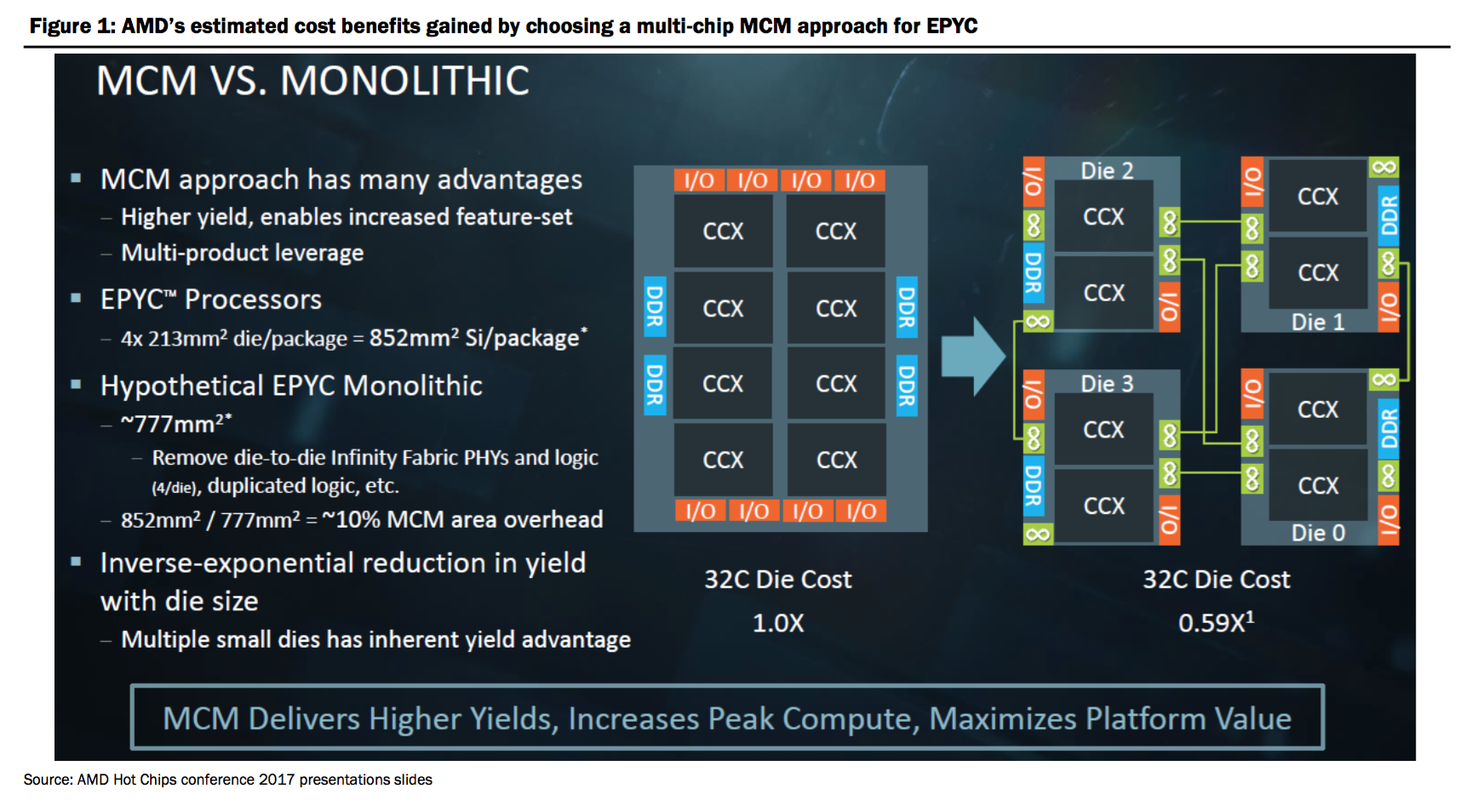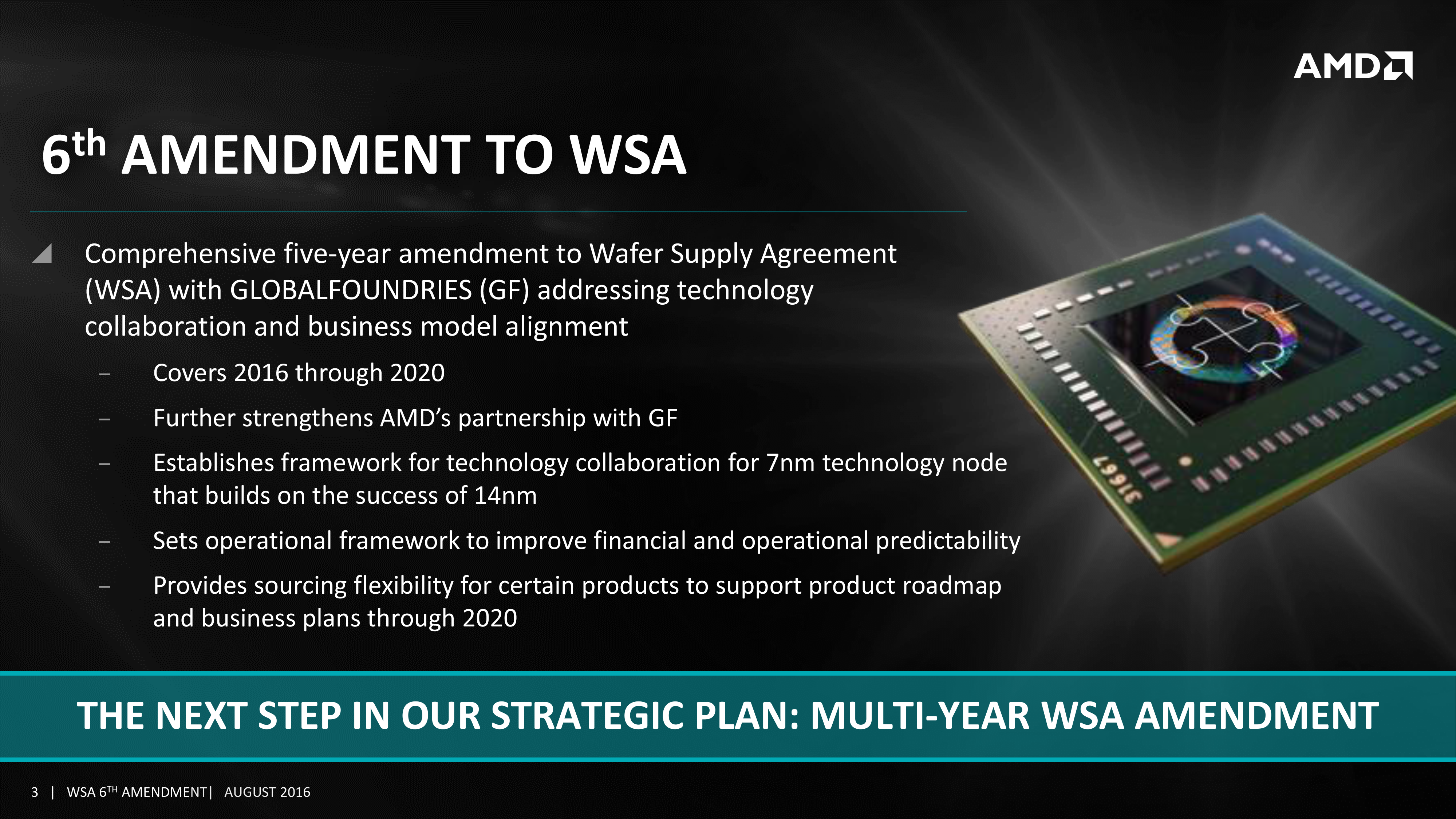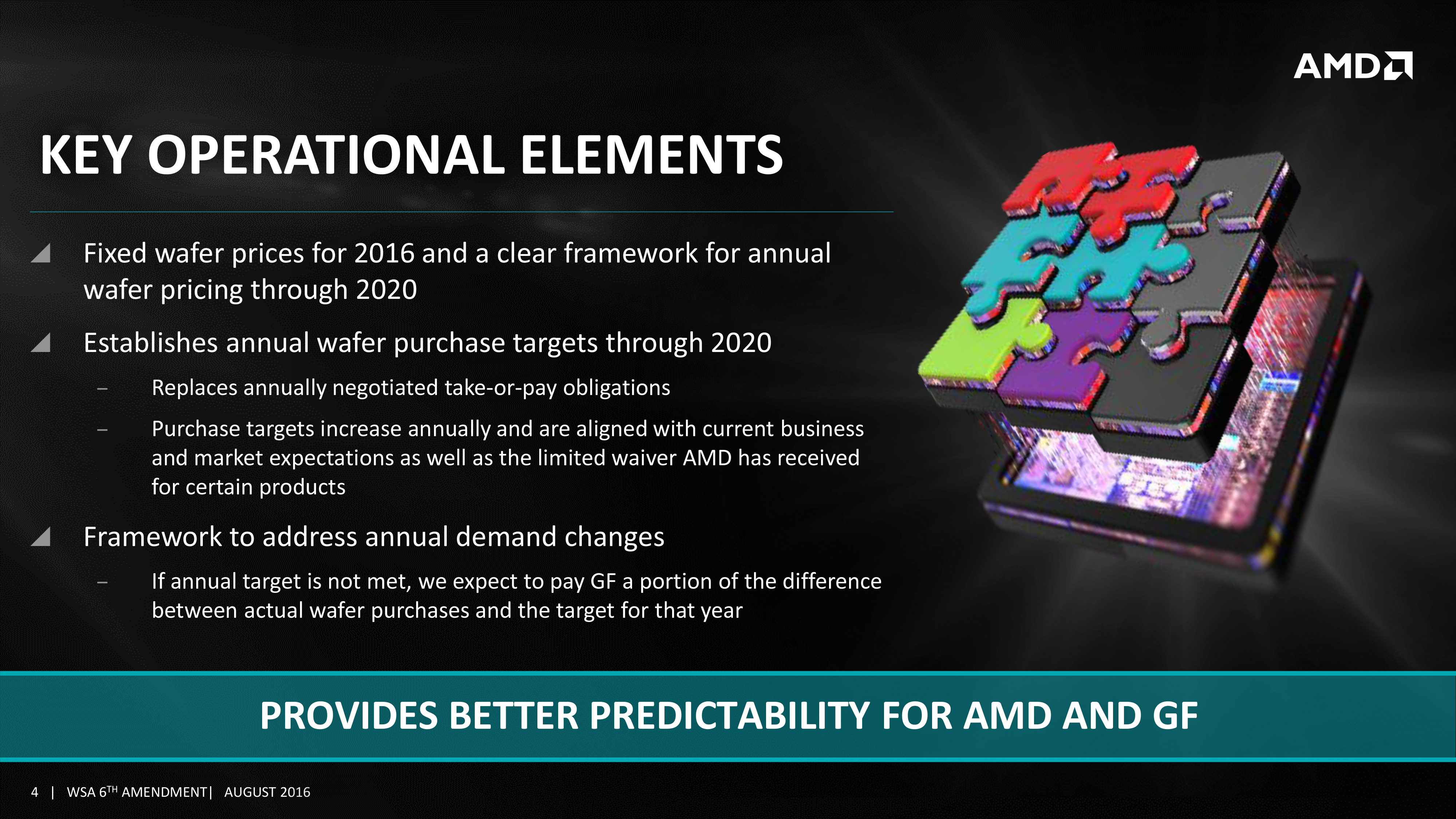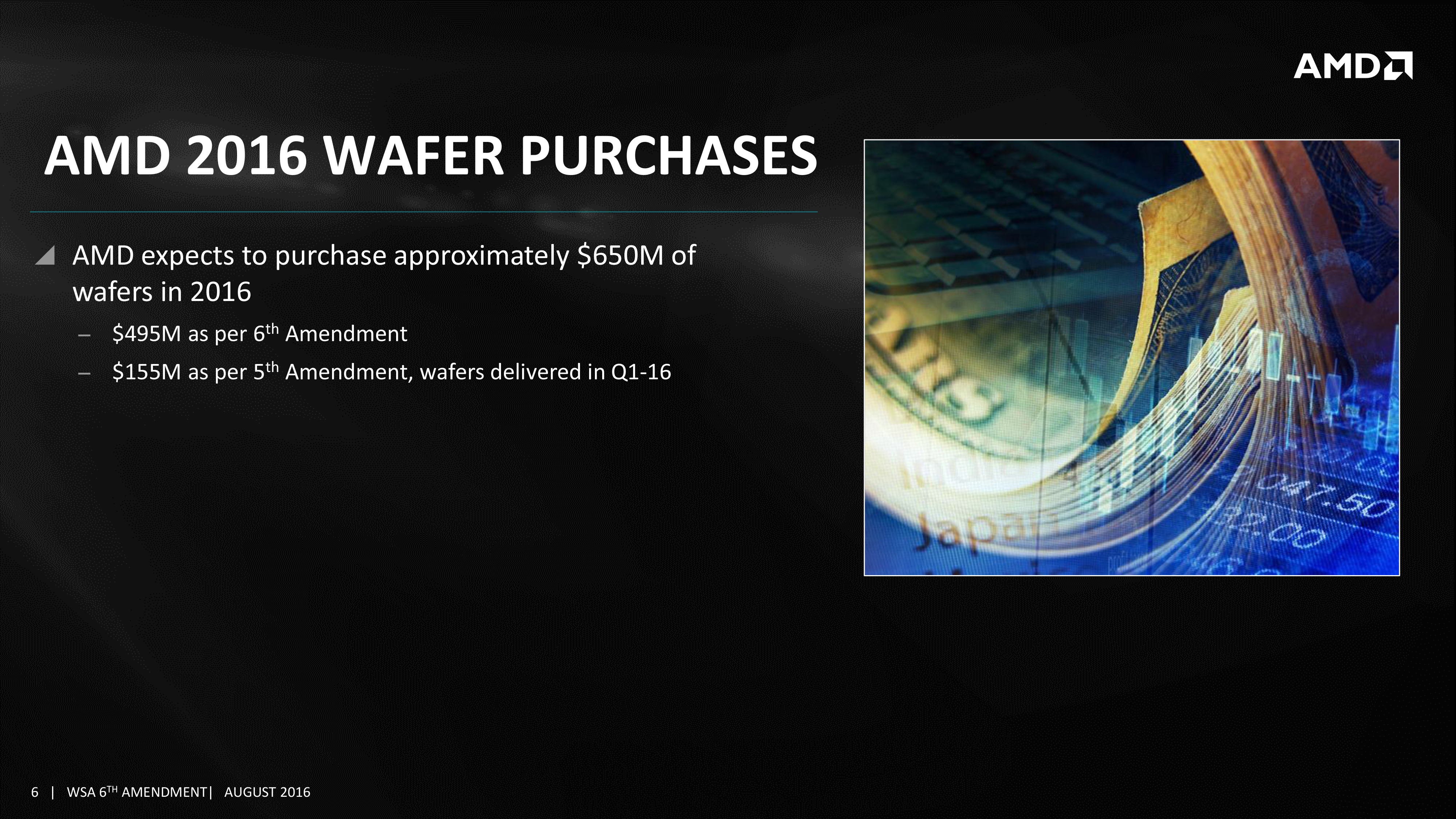Canaccord Genuity’s Matthew Ramsay today reiterates a Buy rating on shares of chip maker Advanced Micro Devices (AMD), and a $20 price target, after reflecting on the company’s presentation at the "Hot Chips" conference in Cupertino, California last month, and his own research on the company’s sales trends.
“Overall, while we recognize roadmap execution and competitive risks remain,” writes Ramsay, "we believe risk/reward is still tilted toward the upside."
Ramsay spends a considerable amount of time talking about the company’s “Epyc” server chip. AMD made the controversial decision to string together four separate chips in place of one, as shown in the info-graphic at the top of this post.
While there may be “corner cases” where the approach is beaten by Intel’s (INTC) “Xeon” chip, Ramsay overall sees the decision as a good one on AMD’s part:
Given cost/yield realities of n- node silicon, AMD chose to design its initial EPYC server products as 4-chip multi-chip modules (MCMs) versus as single larger chips, and this has proven an area of debate in our investor conversations versus the single-die approach taken by Intel. While this design choice has many benefits including lower costs, higher yields and a simplification of the roadmap, we acknowledge there are corner cases where non-uniform memory access latency could be problematic. However, we believe essentially all high-tier software and modern OS kernels are NUMA-aware and believe AMD has only excluded initial EPYC systems from a very small subset of the server TAM through this design compromise. The benefits, however, are substantial in terms of roadmap simplicity and chip yields. In fact, as shown in Figure 1 below, AMD estimates 41% cost savings in a 4-chip 32-core package versus a single 32-core EPYC chip. In addition, important reliability availability serviceability (RAS) features are included in EPYC and leverage AMD's Infinity Fabric enhances system design flexibility and scalabliity – for instance, close integration with AMD's Radeon Instinct GPU accelerators. We believe the Hot Chips talk adds to our recent discussions with CTO Mark Papermaster (and more importantly EPYC customer endorsements) to further dispel the myth EPYC is just four desktop CPUs linked together.
While we certainly do not anticipate AMD will compete across the full breadth of Intel’s server stack or at all price points with even close to the same number of SKUs, we do believe early indications of system design (leveraging the infinity fabric) and the 14/7nm Zen core roadmaps will set price/performance points for memory/IO focused workloads such that our estimates of $1.15B in server revenue (or roughly 7% of the TAM) by 2020 are quite realistic and conservative. Additionally, a sensitivity analysis of AMD non-GAAP EPS to EPYC server market share appears in Figure 7 later in this report with 10%+ server share driving material upside to the “at least” $0.75 non-GAAP EPS target set by management.
Ramsay looks forward to chips late next year from AMD that may have smaller feature sizes of 7-nanometer, down from 14-nanometer for the current parts, which will bring a boost to performance.
“7 is the new 10,” Ramsay declares, an allusion to AMD skipping the 10-nanometer node that some chip designers are moving to:
Looking forward at the future desktop and server roadmaps from AMD, we believe 2H/18 will bring the introduction of 7nm products followed by a full year of 7nm products across the portfolio in 2019. By taking the roadmap from 14nm down to 7nm in the next generation, we believe AMD's products can have much higher performance and performance/watt versus today's 14nm Ryzen and EPYC roadmaps. Further, we anticipate these new 7nm products will compete with the 10nm roadmap from Intel. Given our view – shared by Mark Papermaster in our recent discussions – that 7nm foundry silicon is roughly equivalent to Intel's 10nm node in terms of realized performance/density/power, we believe another significant shift in the competitiveness of AMD's products versus Intel's will take place in 2018/19, leaving AMD at process node parity with Intel for the first time in well over a decade. We continue to believe investors underestimate the importance of this roadmap development for AMD's second-generation Zen-based products and primarily focus only on nearer-term results. Should AMD execute the 7nm roadmaps in 2018/19, we believe more substantial share gains could result. In addition, industry contacts indicate datacenter customers watch 7nm developments closely under NDAs and we believe AMD has already "taped out" multiple 7nm chips with positive early indications.
Ramsay also offers a couple thoughts about AMD’s “Vega” graphics chip, which competes with parts from Nvidia (NVDA). He writes that he was “disappointed,” if slightly, with "the performance and perf/watt metrics” of the GPUs.
However, "we do believe Vega increases AMD's higher-tier SAM and crypto-currency demand should help drive solid graphics sales growth near-term and until 7nm Navi GPUs launch in 2018."
Ramsay in addition offers some feedback on sales trends for AMD’s “Ryzen” chips for desktop PCs, trends he finds favorable:
Our checks indicate solid and continued gradual share gains for AMD Ryzen CPU chips across all five top OEMs (Dell, HP, Lenovo, Asus, Acer) – including important Alienware systems from Dell’s gaming division on AMD Threadripper CPUs. In addition, AMD recently launched Ryzen Pro enterprise-focused SKUs with Dell, HP and Lenovo for 2H/17. Given the much more competitive performance and cost structure of Zen-based Ryzen chipsets versus Intel, we estimate AMD will grow its PC CPU business by roughly 50% in 2017 Y/Y (granted versus very poor results in 2016) based mostly on Ryzen desktop products and also that new Zen-based 14nm products yield a gross margin roughly 10-20 points higher than previous 28nm products depending on product SKU.
Ramsay offers one last though about financials: Estimates may be too high for the end of this year and the beginning of next year, he thinks:
While we raise our Q3/17 estimates slightly and remain well above consensus for 2H/18 and for long-term AMD revenue and earnings estimates, we believe consensus estimates for Q4/17 and potentially Q1/18 may be slightly too aggressive given tougher gaming console compares and seasonality combined with an EYPC sales ramp we anticipate will accelerate meaningfully during 1H/18 versus sooner given the server adoption cycle and strong early traction with customers and partners.
Ramsay is modeling Q4 sales this year of $1.32 billion, and EPS of 2 cents per share. The Street is modeling $1.333 billion and 4 cents per share.
For Q1, he models AMD making $1.148 billion and losing 4 cents per share. That compares to consensus for $1.19 billion and 2 cents per share.








